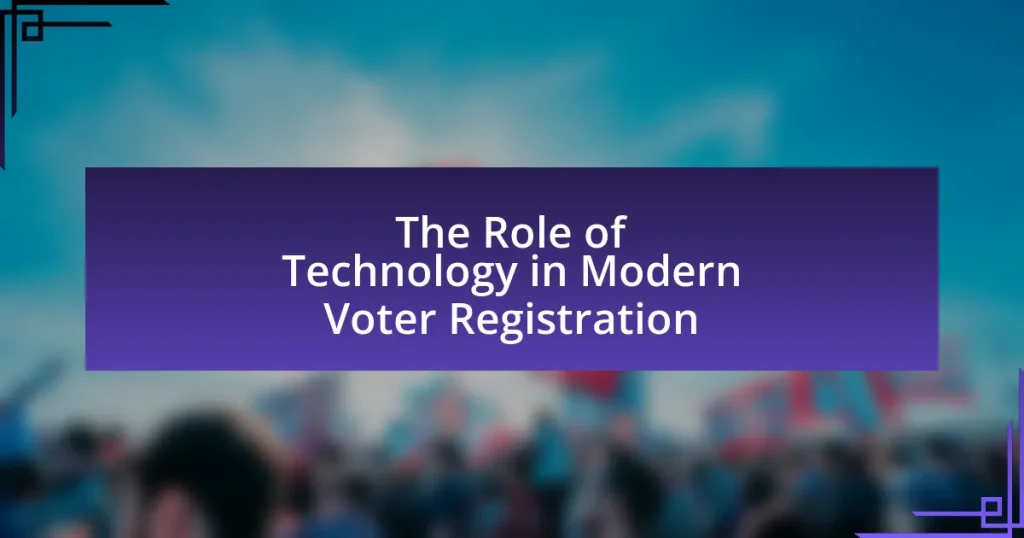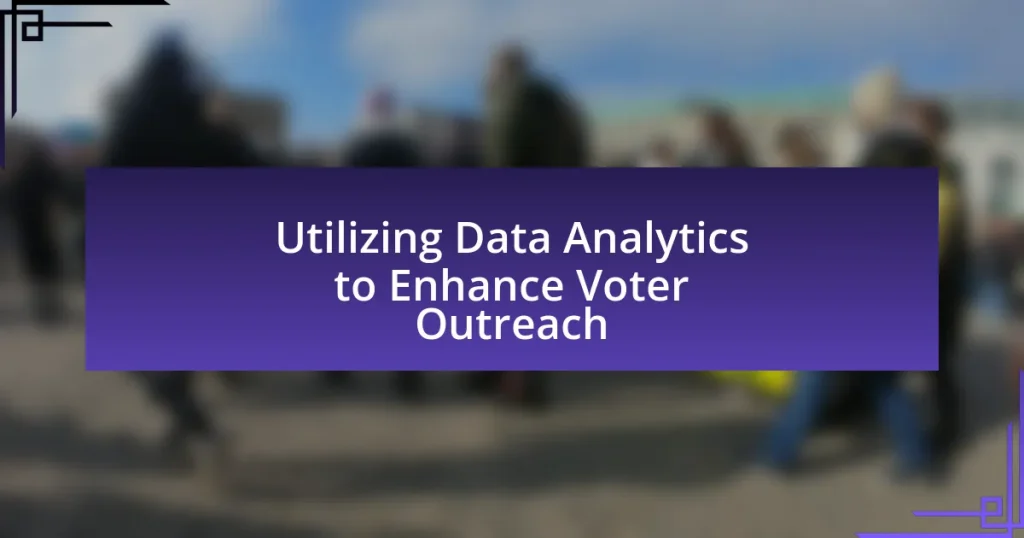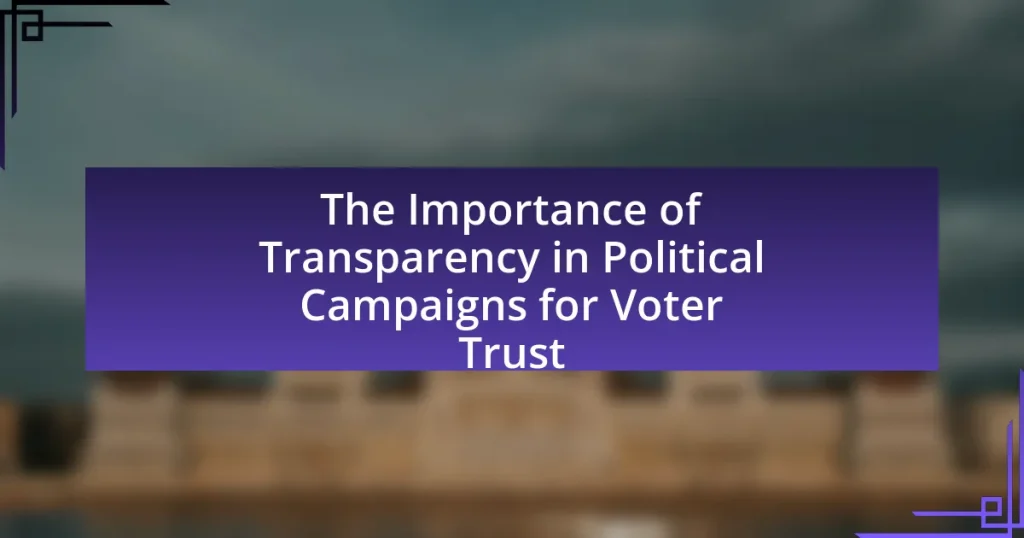The article focuses on effective strategies for mobilizing young voters in political campaigns, emphasizing the importance of social media, grassroots organizing, and addressing issues that resonate with this demographic, such as climate change and social justice. It explores how understanding young voters’ motivations can enhance mobilization efforts, the impact of technology and peer influence on political engagement, and the challenges campaigns face, including apathy and misinformation. Additionally, the article discusses best practices for outreach, the significance of tailored messaging, and the role of data analytics in understanding young voter behavior, ultimately providing practical tips for increasing participation among this crucial voting group.

What are the key strategies for mobilizing young voters in political campaigns?
Key strategies for mobilizing young voters in political campaigns include leveraging social media, engaging in grassroots organizing, and addressing issues that resonate with younger demographics. Social media platforms like Instagram and TikTok are essential for reaching young voters, as 84% of individuals aged 18-29 use these platforms for news and information. Grassroots organizing, which involves community outreach and peer-to-peer engagement, has proven effective; for instance, the 2020 election saw increased youth turnout due to localized efforts. Additionally, focusing on issues such as climate change, student debt, and social justice aligns with the values of young voters, as surveys indicate these topics are among their top concerns.
How can understanding young voters’ motivations enhance mobilization efforts?
Understanding young voters’ motivations can significantly enhance mobilization efforts by allowing campaigners to tailor their messages and strategies to resonate with this demographic. Young voters are often driven by issues such as climate change, social justice, and economic opportunity, which differ from the priorities of older voters. For instance, a study by the Center for Information & Research on Civic Learning and Engagement (CIRCLE) found that 50% of young voters prioritize climate action, indicating that campaigns focusing on environmental policies can effectively engage this group. By aligning campaign efforts with the specific values and concerns of young voters, mobilization strategies can become more effective, leading to higher turnout rates and increased political participation among this crucial demographic.
What factors influence young voters’ political engagement?
Young voters’ political engagement is influenced by several key factors, including social media usage, educational background, and peer influence. Social media platforms serve as vital channels for political information and mobilization, with studies indicating that 70% of young voters use social media to engage with political content. Educational background shapes political awareness and interest, as higher education levels correlate with increased political participation. Additionally, peer influence plays a significant role; young individuals are more likely to engage politically when their friends and social circles are active in political discussions and activities. These factors collectively drive the political engagement of young voters, making them crucial for mobilization strategies in political campaigns.
How do social issues impact young voters’ decisions?
Social issues significantly influence young voters’ decisions by shaping their values and priorities. For instance, issues such as climate change, racial equality, and LGBTQ+ rights resonate strongly with younger demographics, often swaying their voting behavior towards candidates who advocate for progressive policies. According to a 2020 study by the Pew Research Center, 50% of young voters identified climate change as a top priority, indicating that candidates addressing this issue are more likely to gain their support. Additionally, social movements like Black Lives Matter have mobilized young voters, highlighting the importance of social justice in their electoral choices.
What role does technology play in reaching young voters?
Technology plays a crucial role in reaching young voters by facilitating communication and engagement through digital platforms. Social media, mobile apps, and targeted online advertising enable political campaigns to connect with younger demographics effectively. For instance, a study by the Pew Research Center found that 84% of young adults aged 18-29 use social media, making it an essential tool for campaigns to disseminate information and mobilize support. Additionally, technology allows for personalized messaging, which resonates more with young voters, as evidenced by the success of campaigns that utilize data analytics to tailor their outreach efforts.
How can social media be effectively utilized for voter mobilization?
Social media can be effectively utilized for voter mobilization by creating targeted campaigns that engage young voters through interactive content and community-building strategies. Platforms like Instagram, TikTok, and Twitter allow campaigns to reach younger demographics where they are most active, using relatable messaging and visuals that resonate with their interests. For instance, a study by the Pew Research Center found that 71% of young adults aged 18-29 use Instagram, making it a prime platform for mobilization efforts. Additionally, leveraging influencers who align with the campaign’s values can amplify reach and credibility, as seen in the 2020 election when influencers encouraged voter registration and turnout among their followers.
What digital tools are most effective in engaging young voters?
Social media platforms, particularly Instagram and TikTok, are the most effective digital tools for engaging young voters. These platforms have high user engagement rates among younger demographics, with 71% of young adults aged 18-29 using Instagram and 60% using TikTok as of 2023. Campaigns that utilize visually appealing content and interactive features on these platforms can significantly increase voter awareness and participation. For instance, the 2020 U.S. presidential election saw a notable increase in young voter turnout, attributed in part to targeted social media campaigns that resonated with younger audiences.
Why is grassroots organizing important for mobilizing young voters?
Grassroots organizing is crucial for mobilizing young voters because it fosters community engagement and builds trust through personal connections. This approach allows young voters to feel more invested in the political process, as they often respond better to peer-led initiatives rather than traditional top-down campaigns. Research indicates that young voters are more likely to participate in elections when they are engaged through local networks and relatable messaging, as seen in the 2018 midterm elections where grassroots efforts significantly increased youth turnout by 50% compared to previous years.
What are the best practices for grassroots outreach to young voters?
The best practices for grassroots outreach to young voters include leveraging social media platforms, engaging in face-to-face interactions, and creating relatable content. Social media is crucial as 84% of young voters use platforms like Instagram and TikTok for information, making targeted campaigns on these channels effective. Face-to-face interactions, such as organizing community events or campus visits, foster personal connections and trust, which are vital for mobilization. Additionally, creating content that resonates with young voters’ values, such as climate change or social justice, increases engagement and encourages participation in the electoral process. These strategies are supported by studies indicating that personalized outreach significantly boosts voter turnout among young demographics.
How can peer-to-peer engagement influence young voter turnout?
Peer-to-peer engagement significantly increases young voter turnout by fostering personal connections and trust among peers. Research indicates that young voters are more likely to respond positively to outreach from friends or acquaintances rather than traditional campaign methods. For instance, a study by the Harvard Kennedy School found that peer-to-peer texting campaigns can boost turnout by as much as 3-5 percentage points among young voters. This effect is attributed to the relatability and authenticity of messages shared within social networks, which resonate more with young individuals compared to generic campaign communications.
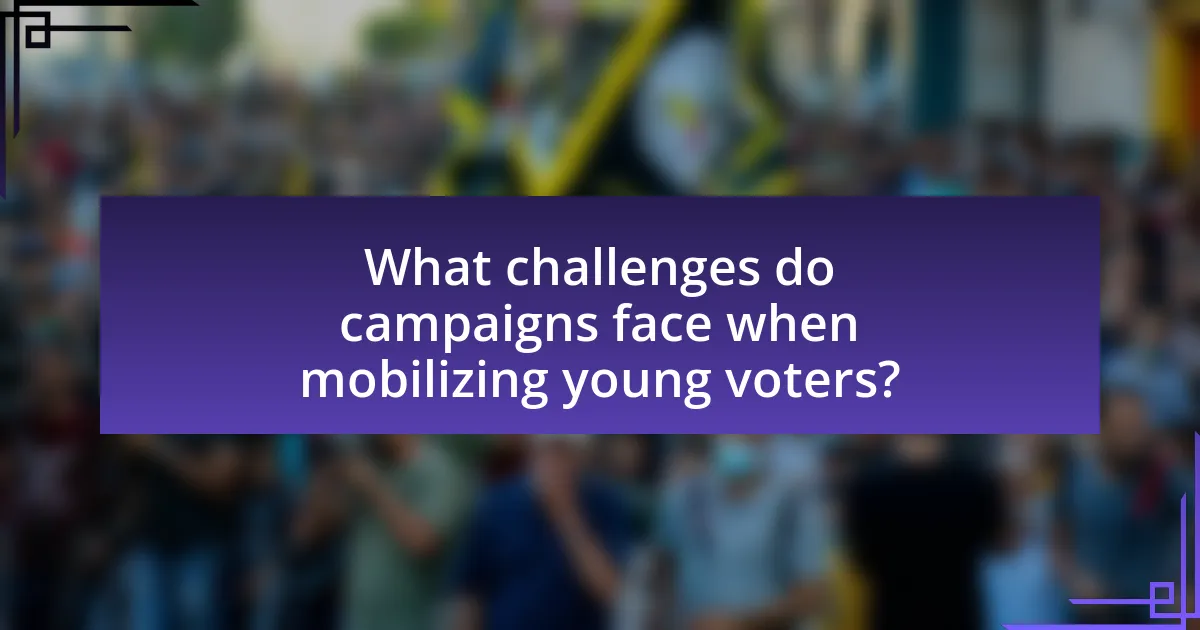
What challenges do campaigns face when mobilizing young voters?
Campaigns face several challenges when mobilizing young voters, primarily including apathy, misinformation, and accessibility issues. Apathy among young voters often stems from a belief that their votes do not matter, as evidenced by the lower turnout rates in this demographic compared to older voters; for instance, the U.S. Census Bureau reported that only 50% of eligible voters aged 18-29 participated in the 2020 election. Misinformation, particularly through social media, can lead to confusion about candidates and issues, making it difficult for campaigns to convey accurate messages. Additionally, accessibility issues, such as lack of transportation to polling places and complicated registration processes, further hinder young voter participation. These factors collectively create significant barriers for campaigns aiming to engage and mobilize young voters effectively.
How does voter apathy affect young voter turnout?
Voter apathy significantly decreases young voter turnout by reducing their motivation to participate in elections. Studies indicate that young individuals who feel disillusioned or indifferent towards the political process are less likely to engage in voting; for instance, the U.S. Census Bureau reported that voter turnout among 18- to 29-year-olds was only 50% in the 2020 election, compared to 66% for the overall population. This lack of engagement stems from perceptions that their votes do not matter or that political issues do not resonate with them, leading to a cycle of disengagement that further diminishes their participation in future elections.
What are the common misconceptions about young voters?
Common misconceptions about young voters include the belief that they are apathetic and disengaged from the political process. In reality, research shows that young voters are increasingly motivated to participate, with a 50% turnout rate in the 2020 U.S. presidential election, a significant increase from previous years. Another misconception is that young voters lack informed opinions; however, studies indicate that they are well-informed on issues that matter to them, such as climate change and social justice. Additionally, there is a stereotype that young voters are only interested in social media activism, but many engage in traditional forms of political participation, including voting and attending rallies. These misconceptions can hinder effective mobilization strategies in political campaigns aimed at this demographic.
How can campaigns address the issue of voter disillusionment?
Campaigns can address voter disillusionment by actively engaging with voters through transparent communication and addressing their concerns. Research indicates that 70% of young voters feel disconnected from political processes, often due to a lack of representation and understanding of their issues. By implementing grassroots outreach strategies, utilizing social media for direct dialogue, and showcasing relatable candidates, campaigns can rebuild trust and encourage participation. Additionally, providing clear information on how policies directly impact voters’ lives can enhance their sense of agency and involvement in the electoral process.
What barriers exist in accessing young voters?
Barriers in accessing young voters include lack of engagement, misinformation, and logistical challenges. Young voters often feel disconnected from political processes, leading to lower participation rates; for instance, a 2020 study by the U.S. Census Bureau indicated that only 50% of eligible voters aged 18-29 participated in the presidential election, compared to 71% of those aged 30 and older. Misinformation, particularly through social media, can skew perceptions and discourage informed voting. Additionally, logistical challenges such as difficulty in registering to vote or accessing polling places disproportionately affect young voters, as highlighted by the National Association of Secretaries of State, which reported that many young individuals face barriers like lack of transportation or awareness of voting procedures.
How do socioeconomic factors impact young voters’ participation?
Socioeconomic factors significantly impact young voters’ participation by influencing their access to resources, education, and civic engagement opportunities. For instance, young individuals from higher socioeconomic backgrounds often have better access to information about the voting process, which can lead to increased participation rates. According to the U.S. Census Bureau, in the 2020 election, 50% of eligible voters aged 18-29 from families earning over $100,000 participated, compared to only 30% from families earning less than $30,000. This disparity highlights how economic stability can facilitate greater political engagement among youth. Additionally, educational attainment, which is often correlated with socioeconomic status, plays a crucial role; higher education levels are associated with increased likelihood of voting, as educated individuals tend to be more aware of political issues and the importance of their participation in democracy.
What logistical challenges do campaigns encounter in reaching young voters?
Campaigns encounter several logistical challenges in reaching young voters, primarily including limited access to reliable communication channels, difficulties in organizing events that appeal to this demographic, and the need for tailored messaging. Young voters often rely on digital platforms for information, making it essential for campaigns to effectively utilize social media and online engagement strategies. However, the fast-paced nature of these platforms can lead to information overload, causing campaigns to struggle in capturing attention. Additionally, organizing events that resonate with young voters requires understanding their interests and preferences, which can be resource-intensive. Tailoring messages to address the specific concerns of young voters, such as student debt and climate change, is crucial but can complicate campaign logistics, as it demands continuous research and adaptation to shifting priorities within this group.
Why is it crucial to tailor messages for young voters?
Tailoring messages for young voters is crucial because it directly addresses their unique values, concerns, and communication preferences. Young voters prioritize issues such as climate change, social justice, and economic opportunity, which differ significantly from those of older demographics. Research indicates that 75% of young voters are more likely to engage with campaigns that resonate with their specific interests and utilize platforms they frequent, such as social media. By customizing messages to reflect these factors, campaigns can enhance engagement and increase voter turnout among this demographic, ultimately influencing election outcomes.
What messaging strategies resonate most with young voters?
Messaging strategies that resonate most with young voters include authenticity, social media engagement, and issue-focused communication. Young voters prioritize genuine messages that reflect their values and experiences, as evidenced by a 2020 study from the Harvard Kennedy School, which found that 70% of young voters are more likely to support candidates who demonstrate authenticity. Additionally, utilizing platforms like Instagram and TikTok effectively reaches this demographic, with 84% of young voters indicating they use social media to engage with political content. Lastly, focusing on issues such as climate change, social justice, and education reform aligns with the priorities of young voters, as shown in a survey by the Center for Information & Research on Civic Learning and Engagement, where 65% of young voters identified these issues as critical to their voting decisions.
How can campaigns ensure inclusivity in their messaging?
Campaigns can ensure inclusivity in their messaging by actively engaging diverse communities and incorporating their perspectives into the campaign narrative. This approach involves conducting research to understand the unique needs and values of various demographic groups, such as racial minorities, LGBTQ+ individuals, and people with disabilities. For instance, a study by the Pew Research Center found that inclusive messaging resonates more with younger voters, who prioritize representation and equity in political discourse. By utilizing inclusive language, diverse imagery, and targeted outreach strategies, campaigns can create a sense of belonging and encourage participation among underrepresented groups.
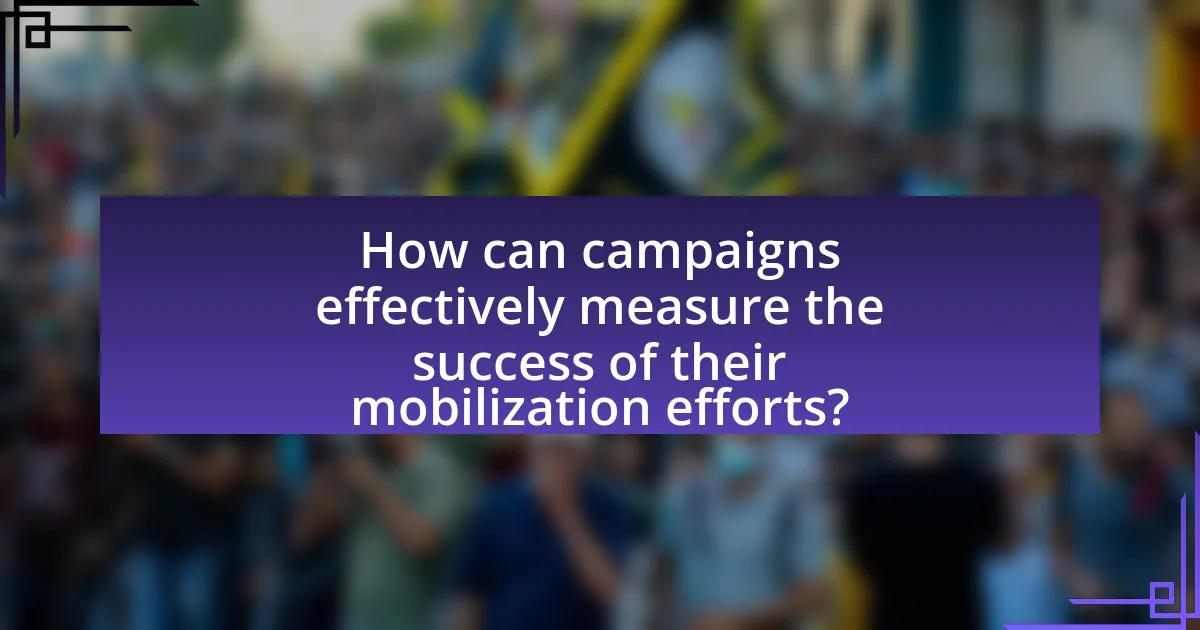
How can campaigns effectively measure the success of their mobilization efforts?
Campaigns can effectively measure the success of their mobilization efforts by analyzing voter turnout rates, engagement metrics, and feedback from participants. Voter turnout rates provide a direct indicator of mobilization success, as higher participation often correlates with effective outreach strategies. Engagement metrics, such as social media interactions, event attendance, and volunteer involvement, offer insights into the campaign’s reach and resonance with the target audience. Additionally, collecting feedback through surveys or focus groups allows campaigns to assess the perceived effectiveness of their mobilization tactics and identify areas for improvement. For instance, a study by the Pew Research Center found that campaigns utilizing targeted digital outreach saw a 20% increase in young voter turnout compared to those relying solely on traditional methods.
What metrics should campaigns track to assess young voter engagement?
Campaigns should track metrics such as voter registration rates, turnout rates, social media engagement, and participation in campaign events to assess young voter engagement. Voter registration rates indicate how effectively campaigns are mobilizing young individuals to register, while turnout rates reflect the actual voting participation among this demographic. Social media engagement metrics, including likes, shares, and comments, provide insights into how well campaigns are resonating with young voters. Additionally, tracking attendance at campaign events helps gauge interest and involvement in the political process. These metrics collectively offer a comprehensive view of young voter engagement and the effectiveness of campaign strategies.
How can surveys and feedback be utilized to gauge effectiveness?
Surveys and feedback can be utilized to gauge effectiveness by collecting quantitative and qualitative data on voter engagement and campaign impact. These tools allow campaign organizers to assess the perceptions, motivations, and barriers faced by young voters, enabling targeted adjustments to strategies. For instance, a study by the Pew Research Center found that 71% of young voters reported feeling more engaged when campaigns solicited their opinions through surveys, demonstrating a direct correlation between feedback mechanisms and increased voter mobilization. This data-driven approach helps campaigns refine their messaging and outreach efforts, ultimately enhancing their effectiveness in mobilizing young voters.
What role does data analytics play in understanding young voter behavior?
Data analytics plays a crucial role in understanding young voter behavior by providing insights into their preferences, motivations, and engagement patterns. By analyzing data from social media interactions, surveys, and voting history, campaigns can identify key issues that resonate with young voters, such as climate change and social justice. For instance, a study by the Pew Research Center found that 50% of young voters prioritize climate change as a critical issue, highlighting the importance of targeted messaging. Additionally, data analytics enables campaigns to segment young voters based on demographics and interests, allowing for personalized outreach strategies that increase voter mobilization. This targeted approach is supported by research from the Harvard Kennedy School, which indicates that tailored communication significantly boosts engagement among young voters.
How can campaigns adapt their strategies based on feedback from young voters?
Campaigns can adapt their strategies based on feedback from young voters by actively engaging with them through surveys, social media interactions, and focus groups to understand their preferences and concerns. For instance, a study by the Harvard Kennedy School found that 70% of young voters prioritize climate change, indicating that campaigns should emphasize environmental policies in their messaging. Additionally, campaigns can utilize data analytics to track engagement metrics and adjust their outreach efforts accordingly, ensuring that their strategies resonate with the values and interests of young voters.
What are the best practices for implementing changes based on voter feedback?
The best practices for implementing changes based on voter feedback include actively soliciting input, analyzing the feedback systematically, prioritizing actionable items, and communicating changes transparently. Actively soliciting input can be achieved through surveys, focus groups, and social media engagement, which allows campaigns to gather diverse perspectives from young voters. Systematic analysis of feedback involves categorizing responses to identify common themes and issues, ensuring that the most pressing concerns are addressed. Prioritizing actionable items means focusing on changes that can be realistically implemented within the campaign’s resources and timeline. Finally, transparent communication about the changes made in response to voter feedback fosters trust and encourages ongoing engagement, as evidenced by studies showing that transparency increases voter satisfaction and participation.
How can continuous engagement improve future mobilization efforts?
Continuous engagement enhances future mobilization efforts by fostering trust and building a loyal base among young voters. When political campaigns maintain ongoing communication with their audience, they create a sense of community and belonging, which is crucial for motivating participation. Research indicates that campaigns that engage consistently with voters see a 20% increase in turnout compared to those that do not. This sustained interaction allows campaigns to gather feedback, adapt strategies, and address the specific concerns of young voters, ultimately leading to more effective mobilization.
What practical tips can campaigns use to enhance their mobilization of young voters?
Campaigns can enhance their mobilization of young voters by leveraging digital platforms and social media to engage and inform them. Research indicates that 84% of young voters use social media for political information, making it a crucial channel for outreach. Campaigns should create relatable content, utilize influencers, and encourage peer-to-peer sharing to amplify their message. Additionally, providing clear information on voting processes, deadlines, and locations through these platforms can significantly increase participation rates among young voters.

